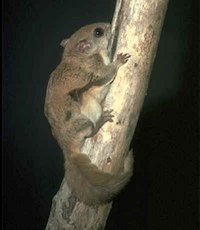Southern flying squirrel: Glaucomys volans
Northern flying squirrel: Glaucomys sabrinus
| Flying Squirrels Southern flying squirrel: Glaucomys volans Northern flying squirrel: Glaucomys sabrinus |
 |
|
| Southern Flying Squirrel |
Northern Flying Squirrel |
| Habitat: Mature
deciduous or mixed deciduous/coniferous forests with an abundance of
various nut-producing trees. Weight: Southern flying squirrel, 1.8 to 2.5 ounces. Northern flying squirrel, 2 to 4.4 ounces. |
Length: Southern flying
squirrel, 8 to 10 inches. Northern flying squirrel, 9.8 inches to 11.5
inches. Food: Acorns, nuts, seeds, berries, blossoms, mushrooms, moths, beetles, small birds, and their eggs. There are commercially prepared baits specially made for capturing flying squirrels. |
| Identification: Flying squirrels have soft, gray-brown fur on the back and sides, with white underparts, a flattened tail and large, dark eyes for night vision. The northern flying squirrel is slightly darker and redder than the southern flying squirrel. The loose folds of skin between the front and hind legs of these squirrels enables them to "fly"; they actually glide through the air on the stretched surface of this loose skin. | Range: The southern flying squirrel is found from southern Canada south to southern Florida, west to Minnesota and eastern Texas. The northern flying squirrel is found from southeastern Alaska and northern Canada south to Tennessee and west to the Pacific coast. |
|
Reproduction: Mating
occurs in late winter, and after a 40-day gestation period, an
average of three to four young are born. A second breeding period occurs
in the summer. The young are born blind and helpless but develop
more quickly than other squirrels. By six weeks of age, they are
able to forage on their own. Tree cavities, attic spaces, and even bird
houses may be used as nesting sites. The nest may be lined with shredded
bark, leaves, moss, feathers, and other materials. Management of Problem Squirrels: Most complaints about flying squirrels are from homeowners with squirrels in their houses. Squirrels will readily take up residence in a building if access is available to a sheltered area. Flying squirrels enter homes through small holes around dormers, ridge vents, eaves, attic vents, and similar vulnerable areas. All such holes should be closed with closed cell foam and backed up with copper mesh to prevent squirrels and other chewing animals from gaining entrance. Be sure that no squirrels are trapped inside. Adults can cause severe damage by chewing to regain entrance to reach their young. If chewing persists, heavy, half-inch wire mesh can be temporarily placed over the problem area. Trimming shrubs and vines and pruning overhanging tree limbs may discourage squirrels from causing future problems. The trapping of flying squirrels can temporarily solve a persistent problem but will not help if the access points around the structure are not sealed to prevent re-occupation. This may require the services of a wildlife control professional. |
Interesting Facts:
Depending on the air current, flying squirrels may glide 150 feet or
more from a height of 60 feet. They can turn easily at right angles
while gliding and control the direction of their glide by tensing and
turning their their legs and body and flapping their tail. As a flying
squirrel approaches its' landing, the squirrel flips its' tail up and
holds its' body back to slow the glide down, giving the squirrel ample
time to position its' feet for grasping the tree trunk. Flying squirrels
usually land face up and often run up the tree immediately after
landing.
Flying squirrels are active year-round, are highly sociable, and will feed and den together, especially during periods of harsh weather. There are even reports of flying squirrels denning with other animals, including screech owls and bats. When feeding on tree nuts, they will
characteristically make one opening in the shell to extract the meat. In
contrast, other squirrels and viagra soft online chipmunks break the nuts into many pieces
to obtain the meat. They store food for winter use in den trees or
underground. |
| Copyright 2005.
Wildlife Control
Supplies. All Rights Reserved. Inquiries | Privacy | Site Map |